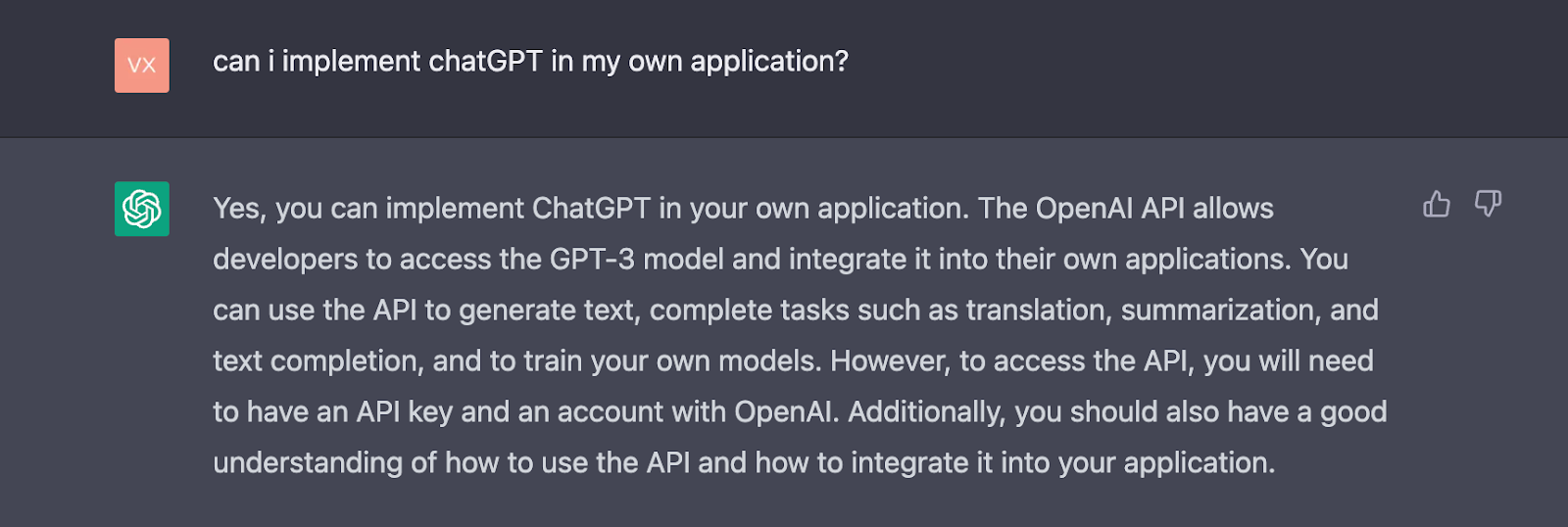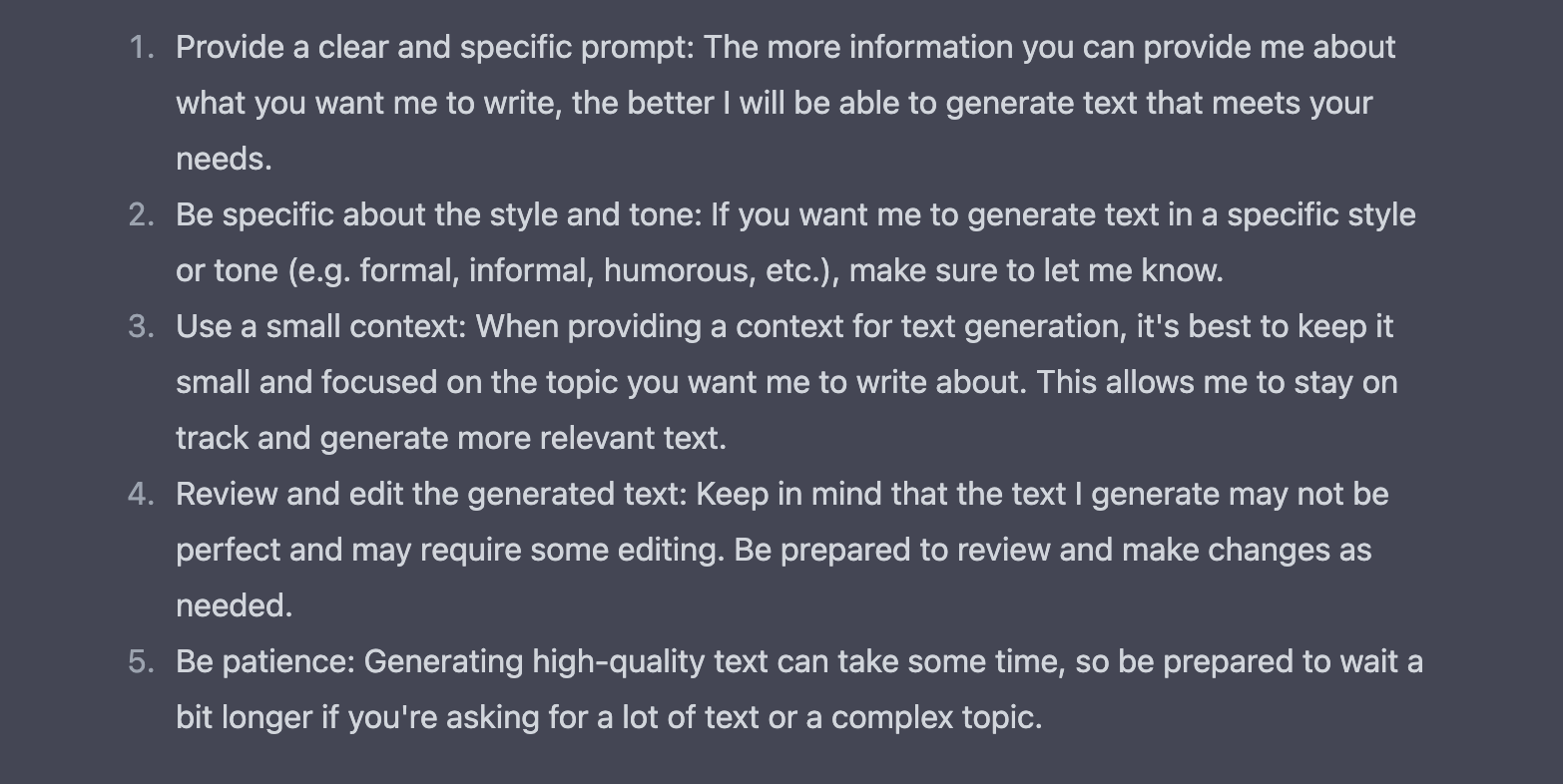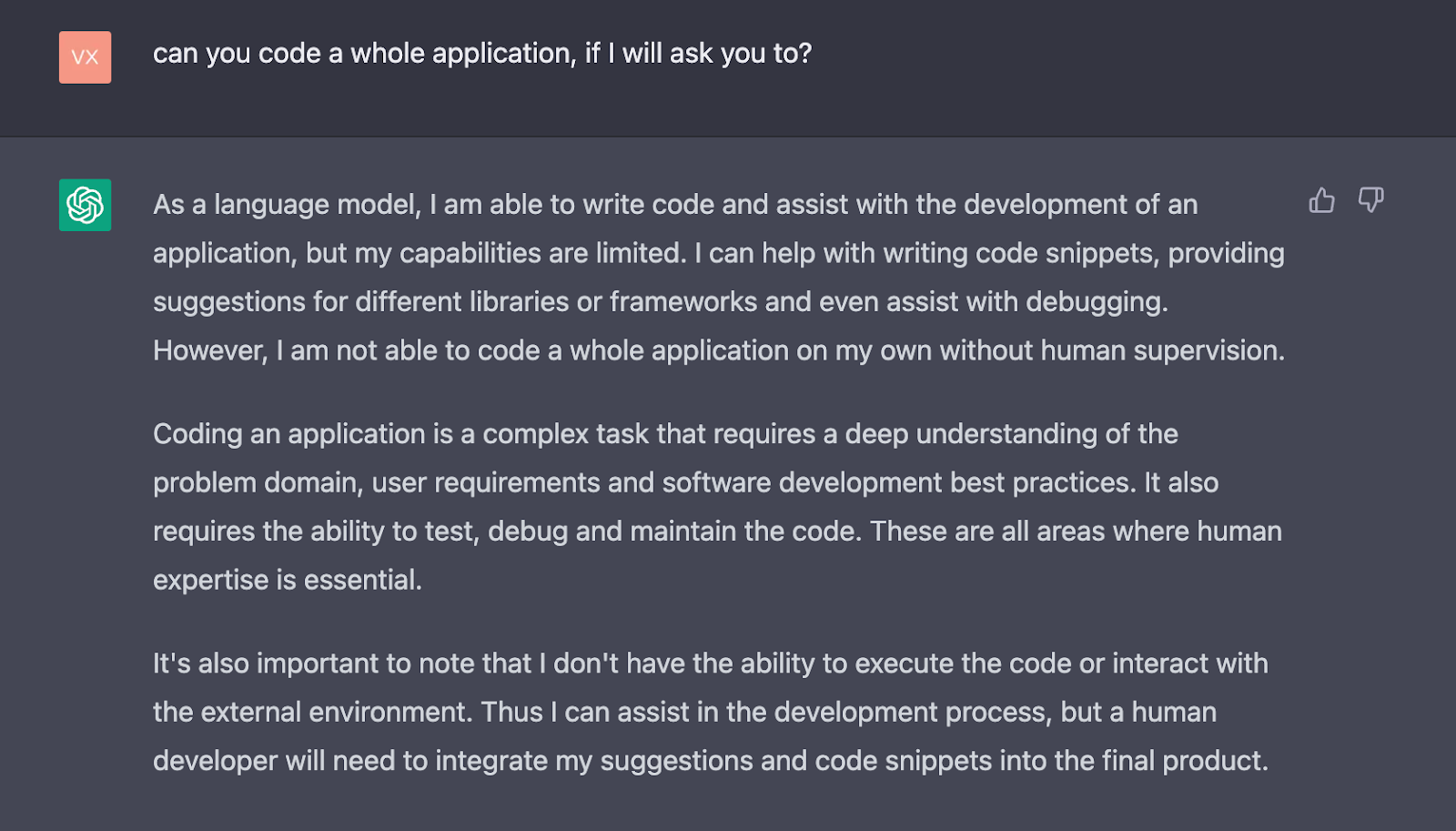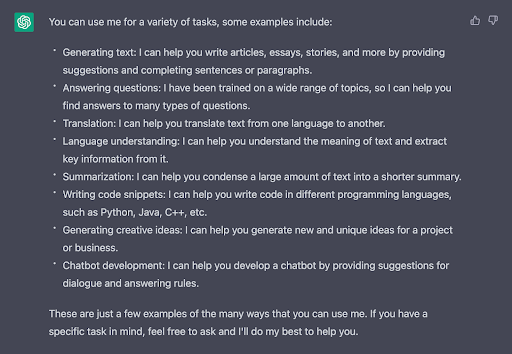Guide on How to Use ChatGPT for Various Purposes
January 31, 2023 • 1027 Views • 15 min read
Tetiana Stoyko
CTO & Co-Founder
After we have tested the potential of ChatGPT in app development and examined the technology’s limitations and ethical considerations, it is time to figure out how to use the features and functionality proposed by OpenAI properly.
First of all, let’s define what services can be provided by this artificial intelligence, i.e. what can and can’t ChatGPT do. It is a natural language processing tool. Therefore, it mainly proposes text responses, including code samples. Unfortunately, other types of media are not supported, at least for now. Instead, you can try the DALLE2 for visual media recognition, or Whisper for voice and audio files. So what does ChatGPT can?
Use Cases of ChatGPT
Personal Assistant and Chatbot
Clearly, the most obvious purpose to use this software is to use it as a Chatbot. However, truth be told, the only one, who is able to use ChatGPT for this specific goal is OpenAI. Despite the name, and free access to the technology for regular users, ChatGPT is not a fully open-source solution. For example, if you want to get a chance for implementing this software into your application, you will need to apply for ChatGPT API Key generation. As a result, before it is generated, you will have to pass the minimum requirements and prove your expertise level:

To make it simple, the OpenAI developers are giving access mainly to other experts in the field of IT, in order to test and train this technology properly. So, if you want to implement it just for fun, or have no clear vision of how to use it, most likely, you won’t get a chance. Yet, it is rather a subjective opinion and if you want to know more details, it is better to contact the owners of the ChatGPT directly on their website.
Text Generation Capabilities
The next great purpose to use this software is as a content generator. Previously, we have already examined its capabilities in this field. For a better illustration, you can check the article on limitations and ethical considerations of using ChatGPT, where we also added an unedited sample of text, fully generated by the AI.

Frankly, such functionality shows great results. For example, ChatGPT can write essays, articles, as well as other types of texts. Probably the best indicator of its success is several claims to ban its usage in different spheres, like education, at various IT conferences, or forums.
Despite the fact, that ChatGPT was designed for text generation and because originally it is a language model, you can use it in multiple fields like FinTech, customer service automatization, market analysis, etc. Still, it is important not to blindly believe all its responses.
Obviously, if you requested it to write you a text, you will have to go over the generated content and edit it when needed. Still, the most practical way to work with ChatGPT is to cooperate with other AIs. The list of potential collaborative artificial intelligence instruments depends on your usage purposes. Clearly, copywriters will require one toolset, SEO writers another one, and regular writers have their requirements for the text. The only clear thing - ChatGPT will be a great addition to all the foregoing categories. To add some more, it can be used by all sorts of people for text generation, starting with students, and ending up with niche-experienced developers or other specialists.
Basic Code Samples

ChatGPT is surprisingly good at coding. It is more than giving boilerplate code in response but also knows how to write more untrivial code samples. Moreover, this NLP can distinguish code units, understand them, give a detailed explanation of the code strings, explain what it is responsible for, can figure out possible issues, and provide users with alternative solutions on how to deal with them.
Nonetheless, in order to use the full potential of ChatGPT in coding, you will still need to have at least basic background knowledge in software development. Despite all the benefits of such software, it occasionally gives wrong answers. So, if you have no development background, most likely, you will struggle with constant issues and imperfections on the code level. Eventually, it is incapable of developing an app from a scratch. To rephrase it, ChatGPT is unable to deal with such complex tasks.
Out-of-Box OpenAI Use Cases
All the foregoing use cases are not the final list of the chatbot’s capabilities, just the most popular ones. As a natural language processing model, it also knows how to deal with texts. Including the fact, that this AI is also a chatbot, it is possible to say, that there is a wide range of cool things and possible ways to use ChatGPT. AI can tell you a joke, check the punctuation or write a summary of an existing text. Chatbot operates in English. Regardless, it can easily translate your requests into any language you would like. Some developers, as well as other users, already started using ChatGPT as a fast alternative to Google. Still, do not forget, that it has no direct access to the Internet. Thence, it may not provide you with current information on the topic.
Ultimately, due to its recent appearance, both OpenAI specialists and regular users still can’t figure out all the possible ways to use ChatGPT. Moreover, it is hard to define how exactly will it behave in different industries. Yet, we believe that the answer to this question will be found in the next few years.
With the combination of its novelty, flexibility, and unclear capabilities, this chatbot can and most likely will become a game changer in numerous fields. For example, just now, some software specialists are trying to adjust it to the FinTech industry, and teach it how to better make predictions on stock trading, financial calculations, and perform other similar tasks. Yet, the most crucial “but” is the fact, that ChatGPT is not connected to the Internet, which significantly limits its possibilities.
How to Use OpenAI Properly
Actually, the number of possible lifehacks and alternative ways how to use OpenAI is countless. Additionally, it is impossible to simply list all the possible combinations of the ChatGPT and other software solutions, which will show great results. Nevertheless, we can describe the most basic and essential principles of treating this AI to get the best possible results in the most common use case like content creation, code automation, etc.
ChatGPT Hack: The Less is More!
First of all, it is worth understanding, that ChatGPT has issues with complex tasks. So, if you want it to, let’s suppose, write you an article on a specific topic, then you will have to avoid “write an article on this topic”. Definitely, it will give you a ready text, yet it will vary in volume from the one, you needed. The reason is simple - ChatGPT responses are limited in volume by purpose. This helps to kill two birds with one stone:
First of all, it gives a chance to avoid system overload. As well as any similar software, ChatGPT depends on the servers’ hardware, so it is better to limit the possible load on it to prevent systems’ shutdowns.
Additionally, even the developers admitted, that the more complex or scalable task and chatbot’s response is, the less accurate it can be. So, limiting the response volume allows for avoiding extra mistakes.
This is why try to divide your task into subtasks. Fortunately, this AI is intelligent enough and you can ask it for an approximate plan or outline if you have no ideas on how to better scale your request. As a matter of fact, the same advice you will get from the chatbot itself if you will ask it about the text volume.

Ultimately, the same principle is true for most of the OpenAI use cases. Yet, some of them can’t be fully fulfilled by the chat. For instance, in the case of coding an app with the use of ChatGPT, you won’t be able to develop a whole app using only the code samples, proposed by this AI. When it comes to coding, it is worth understanding, that it has multiple limitations and misconceptions in this field. So, it is impossible to code without human supervision. Still, you can divide a complex task into multiple subtasks, to make it easier for the bot.

How to Use OpenAI with Third-Party Software
We have to admit, that when it comes to using ChatGPT in combination with third-party software, most such solutions are mainly targeted at textual content. As a result, if you are going to work with the content generation abilities of ChatGPT, then you will get a chance to use multiple solutions such as Grammarly, DupliCheck, HuggingFace, etc.
Unfortunately, the variety of such powerful tools for other usage purposes like coding or personal assistance is more limited. So, in these cases, you will have to rely on your own background knowledge or use official documents. For example, in case you are going to use OpenAI for code sample generation, then you can compare the final results with the official docs of the software solution you are interested in.
Still, it is easy to predict, that in the nearest future software instruments for such use, cases will appear as well. Frankly, development enthusiasts are developing out-of-box solutions, based on, or somehow related to ChatGPT.
Set ChatGPT Behaviour
One of the most astonishing features of this chatbot is that it remembers the context of your dialog. Moreover, it understands countless behavior patterns. So, to gain better results, you can set these patterns to the bot, and will see, that ChatGPT corresponds with them.
Do you want it to write you a text? Ask him to behave as Edgar Allan Poe or Mark Twain. Want to have a small talk with a celebrity? Tell ChatGPT to behave as Quentin Tarantino. Looking for more complex code samples? Say him, he is JavaScript Senior now!
Yet, personalities are not the only behavior specific to chatbots. You also may ask this NLP to explain things as if you were 4 y.o., or in accordance with any other species. Do not be afraid to implement creative ideas!
End Line
Summing up all the above, we can assume that it is impossible to create a complete guide on how to use ChatGPT for various purposes.

Nevertheless, it is possible to advise on some major and well-known OpenAI use cases. Despite the list of these recommendations is not final, as well as the list of possible additional tools, the suggestions are:
- Brake your tasks into smaller and easier subtasks,
- Use extra specified instruments, regarding your needs,
- Do not underestimate the role of humans, even if you are willing to use as maximum automation capabilities, as possible. Fortunately or not, ChatGPT is still impossible to replace even a content writer, not talking about more complicated jobs as software developers.
- Examine case studies on various topics, looking for new ideas and industries for ChatGPT implementation.
Also, do not forget, that in our Insights category, you can find other texts, dedicated to ChatGPT, or other innovative real-life chatbot use cases.
What’s your impression after reading this?
Love it!
3
Valuable
1
Exciting
1
Unsatisfied
1
FAQ
Let us address your doubts and clarify key points from the article for better understanding.
you may also like
Let's talk!
This site uses cookies to improve your user experience. Read our Privacy Policy
Accept
Share this article